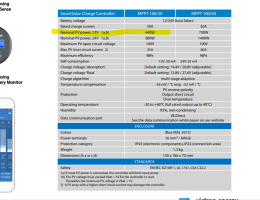I have bought two renology 175w panels to charge a 12v leisure battery.
I have a few newbie questions. Am I best to wire these in parallel and if so would the best option be the Victron 100/30? Do I need to fuse between this and the battery?
Do I need to leave an air gap between the van and the panels? The panels say that you can stick them straight down (which I would prefer), but I have read that this could compromise the panels.
Anything else I need to consider?
Thanks in advance as always!
There are advantages and disadvantages with both series/parallel.
I have two 175W panels in series and run them through a Victron 100/30 and I consider this great. The MPPT starts to charge earlier and cuts charge later than it would if the panels were in parallel. Output is also better in the winter in low light conditions due to the higher voltage of the PV output.
Another advantage of serial connection is that volt drop is reduced and this increases efficiency allowing the use of smaller gauge cables between the panels and the controller.
BUT
If there is shading on either panel, the output is ruined for both panels when panels are in series.
This means that parallel is the better option when shading is likely.
So the answer is "take your pick depending on your circumstances"- Sorry to give you an irritating answer.
I'd go with series roof panels and avoid parking under a tree, just because I value the increased efficiency in the winter.
(If you only use your van in the height of summer and park under a tree for shade when possible, then go series.)
Or what I have done on my caravan-
2x 175W panels in series on roof with Victron 100/30.
Additional stand alone plug to Victron 100/20 with Anderson plug to allow connection of 200W remote panel in shady conditions.
The gap thing-
Solar panels do not like being too hot, but you need to safely fix these things to your van roof -neatly and avoiding potential wind noise. My semi-flexi panels are fully bonded to my van roof as aesthetics are important to me.
I am just in the process of installing 400W or solar to a pop top on a new camper and these are going to be fully bonded down with no gap.
In contrast my caravan panels are rigid panels which have an air gap due to the way they are fixed. They are bulky, unsightly, yet efficient.
Hope this helps.





